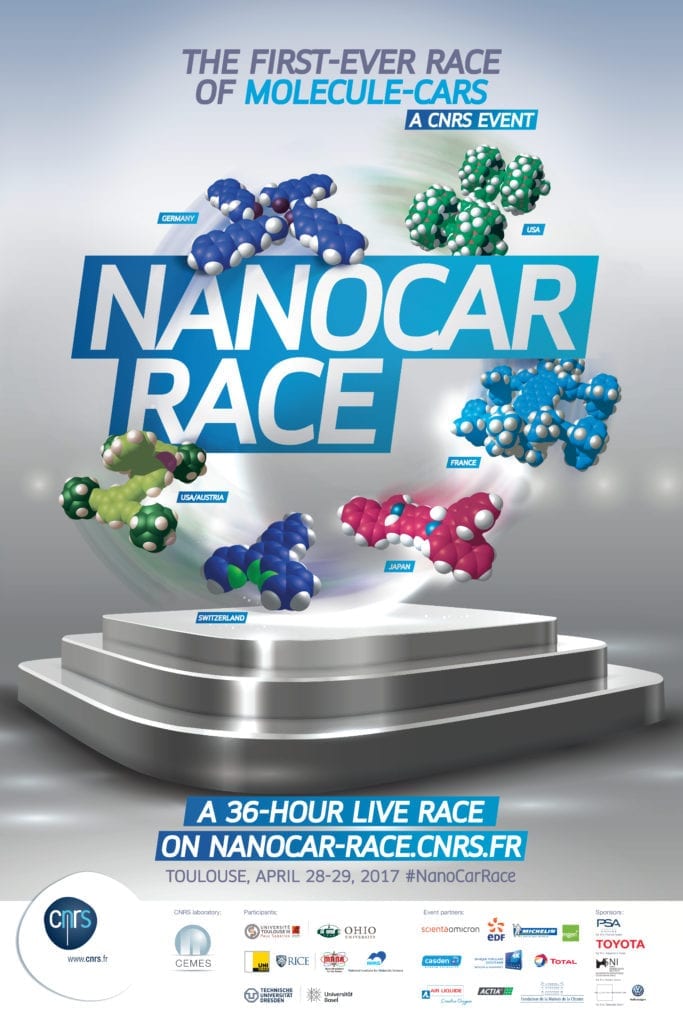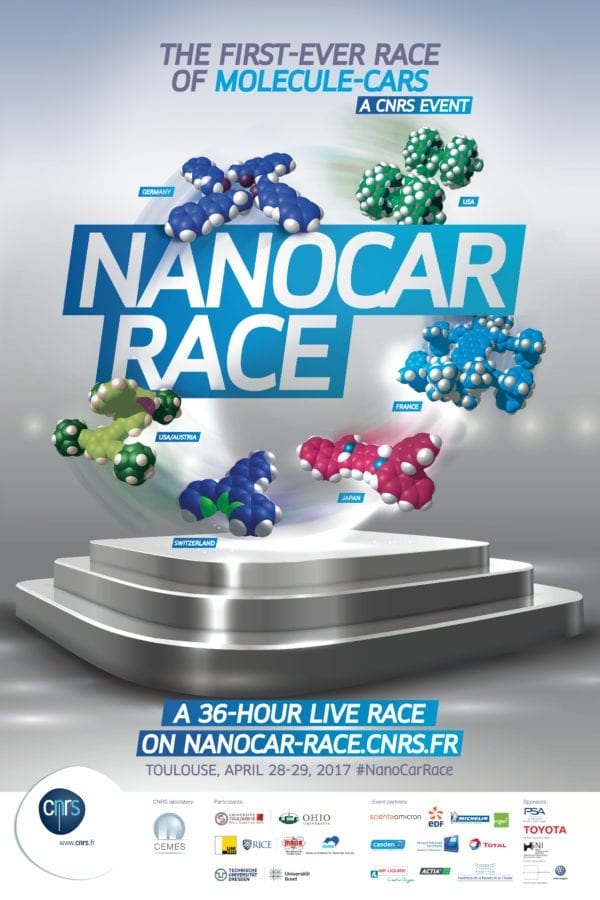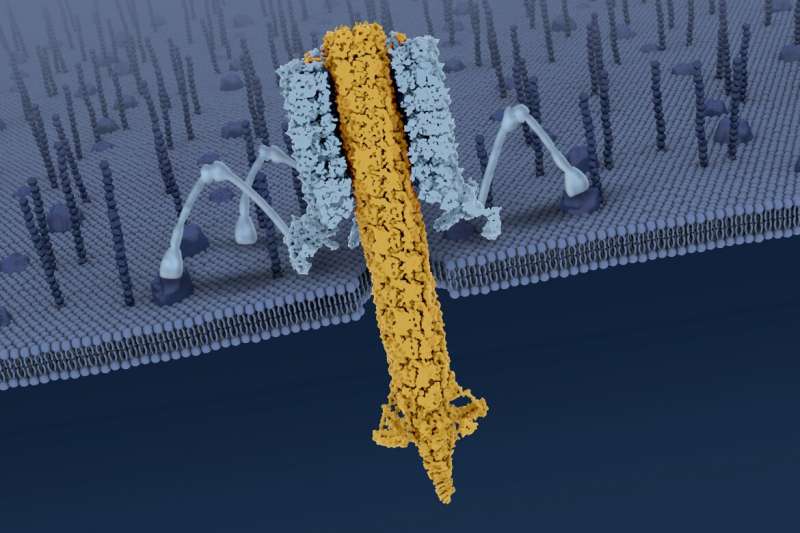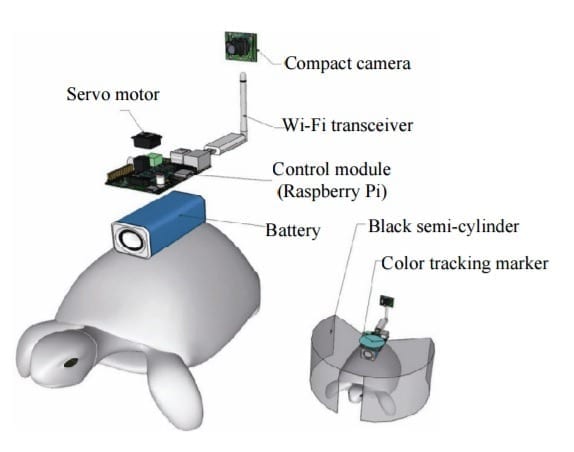
Nanocars will compete for the first time ever during an international molecule-car race on April 28-29, 2017 in Toulouse (south-western France). The vehicles, which consist of a few hundred atoms, will be powered by minute electrical pulses during the 36 hours of the race, in which they must navigate a racecourse made of gold atoms, and measuring a maximum of a 100 nanometers in length.
They will square off beneath the four tips of a unique microscope located at the CNRS’s Centre d’élaboration de matériaux et d’études structurales (CEMES) in Toulouse. The race, which was organized by the CNRS, is first and foremost a scientific and technological challenge, and will be broadcast live on the YouTube Nanocar Race channel. Beyond the competition, the overarching objective is to advance research in the observation and control of molecule-machines.
More than just a competition, the Nanocar Race is an international scientific experiment that will be conducted in real time, with the aim of testing the performance of molecule-machines and the scientific instruments used to control them. The years ahead will probably see the use of such molecular machinery—activated individually or in synchronized fashion—in the manufacture of common machines: atom-by-atom construction of electronic circuits, atom-by-atom deconstruction of industrial waste, capture of energy…The Nanocar Race is therefore a unique opportunity for researchers to implement cutting-edge techniques for the simultaneous observation and independent maneuvering of such nano-machines.
The experiment began in 2013 as part of an overview of nano-machine research for a scientific journal, when the idea for a car race took shape in the minds of CNRS senior researcher Christian Joachim (now the director of the race) and Gwénaël Rapenne, a Professor of chemistry at Université Toulouse III – Paul Sabatier. Three years later, the nanocars are operational and ready to face off on the circuit’s gold surface. There were numerous challenges in organizing this race, from selecting the racecourse, which must accommodate all types of molecule-cars, to adapting the scanning tunneling microscope. The participating teams also had to overcome a series of difficult tasks (depositing and visualizing the molecules beneath the microscope), as well as meet numerous criteria (the molecules’ structure and form of propulsion) in order to participate in this race. Of the nine teams that applied before the end of May 2016, six were selected, and four will take their place at the 4-tip microscope’s starting line on April 28, 2017 for the 36-hour race in Toulouse.
The challenges facing researchers in the race will be so many steps forward in novel fields in chemistry and physics. In the process, each team will build up new skills, data, and know-how that will one day contribute to the development of surface chemistry (which enables chemical synthesis directly on a particular surface), or in the new science of surfaces known as membrane science, which makes it possible to deposit a molecule-machine on the surface of a cell, or to control the movement of a single molecule in a liquid.
The CEMES-CNRS microscope is the only one in the world allowing four different experimenters to work on the same surface. The development of such multi-tip microscopes will enable synchronizing a great number of molecule-machines in order to increase capacity, for instance for storing energy or capturing it from a hot metallic surface. A genuine “atom technology” is dawning.
The rules of the race:
– The racecourse: 20 nm + one 45° turn + 30 nm + one 45° turn + 20 nm, for a total of 100 nm
– 36h maximum duration
– Authorization to change one’s nanocar in case of an accident
– Pushing one’s nanocar is forbidden
– One sector of the gold surface per team
– Maximum 6 hours to clean one’s portion of the course before starting
– No tip changes allowed during the 36 hours
Learn more: The world’s first international race for molecule-cars, the Nanocar Race is on
[osd_subscribe categories=’nanomachines’ placeholder=’Email Address’ button_text=’Subscribe Now for any new posts on the topic “NANOMACHINES”‘]
The Latest on: Nanomachines
[google_news title=”” keyword=”nanomachines” num_posts=”10″ blurb_length=”0″ show_thumb=”left”]
via Google News
The Latest on: Nanomachines
- Fluorescence Microscopy News and Researchon May 14, 2024 at 5:00 pm
The research, which was conducted on mice, demonstrates how these tiny nanomachines are propelled by urea present in urine and precisely target the tumour, attacking it with a radioisotope carried ...
- DNA nanomachineson May 6, 2024 at 7:37 am
We make nanomachines from DNA because the simplicity of its structure and interactions allows us to control its assembly. In this review we concentrate on research that is leading towards the ...
- 7 games that should be adapted for TVon May 4, 2024 at 4:00 am
With shows like Fallout and The Last of Us leading the way, there's massive potential for more TV adaptations with these games.
- The best games to play at WASD 2024on April 25, 2024 at 5:00 pm
The game thrusts you into a dark sci-fi world where you play as Anita, a child augmented with lethal nanomachines that allow her to dash around battle arenas, tearing apart a variety of fearsome ...
- Molecular Communicationon April 17, 2024 at 7:10 pm
Nakano, Tadashi Okaie, Yutaka and Vasilakos, Athanasios V. 2013. Transmission Rate Control for Molecular Communication among Biological Nanomachines. IEEE Journal on ...
- Nanomachines: Learning from Nature to Revolutionize Nanotechnologyon April 8, 2024 at 6:00 am
Nanomachines are nanoscale devices that can perform specific tasks at the molecular level. These tiny machines, typically ranging from 1 to 100 nanometers in size, are found in both biological systems ...
- Molecular Motors: Nature's Nanomachineson April 1, 2024 at 12:09 am
Molecular motors are biological nanomachines that convert chemical energy into mechanical work at the molecular level. These highly efficient and specialized proteins are responsible for a wide range ...
- Synced preview - a pop-punk flavoured post-apocalypseon August 6, 2023 at 4:31 am
Hideous amalgams of nanomachines roam the post-apocalyptic world of first-person shooter Synced – but you won’t be facing them alone. The upcoming co-op FPS sees your character forming an ...
- 10 Awful Movie Death Retcons EVERYONE Hatedon April 21, 2023 at 5:00 pm
"Nanomachines, son." It's revealed that, moments after Harry was shot in the head, Ginger (Halle Berry) arrived on the scene and encased his head in protective "alpha gel," before his damaged ...
via Bing News












